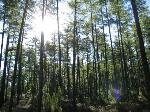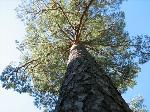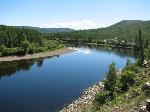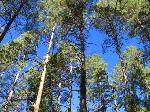- Getting around Lijiang. Dont stay in the Old Towns more than 2 days, there is nothing to do. KRISS Oct 9, 2013 05:46
- 2013 Beijing Temple Fair BENNYLAU Feb 26, 2013 03:29
- Malaysian traveling from KUL - LAX vis Shanghai PVG ZATI_DY Jan 3, 2013 20:15
The Silence of the Trees: Moerdaoga Forest Park
- Views: 6194
- |Vote: 3 0
- |Add to Favorites
- |Recommend to Friends
There’s something about trees…
OK. I confess. I love trees. Just the sight of a tree is enough to bring a smile to my face: a smile at their calm yet momentous presence. I’ve spent a year watching the changing moods of the Indian Bean trees lining the streets of my city, from longing for the slow emergence of their fat leaves to marvelling at their extravagant seed pods worn like jade jewellery. These tough trees survive Liaoning’s –25 winters and remain quiet heroes in the face of industrial pollution: absorbing, filtering, recycling.
Why all this talk of trees, you may ask ? Well, some time ago I saw by chance a photograph of beautiful larch trees with their needles the colour of sunlight and promised myself that one day I would visit this place. Soon to leave the north east of China I resolved to travel beyond the more frequented urban sprawls to find this forest nestled in the far north east of Inner Mongolia. I would go in search of Moerdaoga!
[Image: Benxi streets, late autumn, Indian Bean trees with hanging pods]
Getting to Moerdaoga via Hailaer via Qiqihaer
The internet is unusually silent about Moerdaoga and so it was that, armed with nothing more than my Chinese map and a sense of determination, I arrived in Hailaer. Hailaer, I’d previously decided would be my best chance for reaching Moerdaoga, although I didn’t expect that getting to Hailaer would be the most difficult part of the journey.
Arriving in Baicheng, Jilin Province, I hoped to take a train to Hailaer. It was summer, tickets were gold dust and even the locals couldn’t procure one on my behalf. It also became apparent that no buses travel north out of Baicheng. I was stuck. A train was leaving for Qiqihaer, Heilongjiang Province that happened (according to my map) to be linked by a highway to Hailaer. I bought a ticket and wished myself luck. 4 cramped and sweltering hours later I was in Qiqihaer.
Qiqihaer greeted me with incredible skies, it seemed they might be about to do battle as fierce grey thunderheads lined up against the late afternoon blue. It had obviously been a beautiful day but the heat had triggered a huge storm that was just about to break. I risked an open rickshaw to the bus station where I was told to return the next morning at 5.30am to buy my ticket to Hailaer. I booked into a nearby hotel to watch the fury of the rain against the streets and later that evening would stroll under a sunset so vivid I thought it might set the city alight.
The next morning an 8-hour bus ride would take me out of Heilongjiang Province and into Inner Mongolia, reaching Hailaer late in the afternoon. I was so nervous, feeling so near and yet still so far from my destination, what if it was unreachable, what if it didn’t exist? I approached the ticket seller clutching my map for backup and asked for a ticket to Moerdaoga, I held my breath –
and there it was, my ticket. I kissed it, delighting in the computer printed script that told me tomorrow, at last, I would be going to 莫尔道嘎 (Moerdaoga).
[Image: Qiqihaer's incredible evening skies]
Moerdaoga, at last
Moerdaoga is located in the far north east of Inner Mongolia and is only about 100km south of the border with Russia. The 6-hour journey there was enchanting, following a long straight road through endless grasslands. It seemed the world was green below and blue above: just grass and sky. Punctuating the rolling grassy hills were herds of sleek bronze horses or scatterings of sheep like white seeds. We would as often meet cows on the road as other cars and the bus would slow slightly and swerve in well-practised avoidance.
Travelling ever eastwards the bus left the afternoon behind, the sun setting in our wake and we headed into the darkness of evening. The bus arrived at 8.30pm and with no accommodation booked I was happy to tag along with two Chinese backpackers who befriended me. They had found a lady on the bus who was currently in the process of converting some outbuildings into a guesthouse. None of the rooms were finished but she happened to have 3 beds and it seemed it must be fate – we all decided to stay.
[Image: Clock tower, Moerdaoga town]
Exploring Moerdaoga National Forest Park
The next morning dawned so cold we could see our breath outside and the hillsides were invisible, covered in low-lying cloud. Talking with the owners last night it had become apparent we would have to hire a vehicle to get to the park and so it was that we piled into a bread van with a local driver who would also be our guide.
It was only a 10-minute drive to the park entrance. It’s nothing more than a gateway and ticket office huddled in a gap in the trees and it felt mysterious with nothing but the misty white clouds and silence of the pines. We drove slowly along the dirt road absorbed in the simple splendour of the forest, occasionally disturbing squirrels, mice and voles that darted into the undergrowth. At one point there was a rush of wings and a great bird of prey swooped overhead, the driver said it was an eagle.
Mushrooms & Bilberries
Our first stop was to explore a woody grove where pines and birches mingled their black and white trunks. The air was crisp and refreshing as we wandered through the trees huddled in our fleeces. It seemed so strange to be cold in summer. But, the sun was already beginning to break through sending beams between the trees with the brightness of searchlights.
The driver showed us where to find bilberries, their tiny purple fruits hidden beneath shaded pockets of leaves. He explained they weren’t quite ripe but were still edible and so we hunted for more, tasting their pleasant, juicy bitterness. We also gathered wild mushrooms for dinner that evening, they nosed their way through the logs and fallen branches like miniature fairytale villages.
[Image: Sun through the pines]
A Dream of Pines
Further stops along the way allowed us to get up close and personal with the real stars of this forest, its pine trees. Stop anywhere in this forest park where you’re afforded views into the distance and you’ll see nothing but pines, overwhelming the hills in their hundreds of thousands: a great, green army.
The numerous Camphor pines are instantly recognisable by their strongly scented deep green needles and orange-brown bark. They tower upwards to 30 meters in height and some of the trees here are over 200 years old. One particularly majestic specimen we met was surrounded by a wooden boardwalk, its trunk nearly a meter in diameter and its branches zigzagging outwards overhead.
As the air warmed up a multitude of butterflies appeared. They seemed to be playing with us, darting and spiralling just beyond our reach and never settling long enough to allow us to take a photograph of their delicate beauty. Deer are also glimpsed regularly amidst the pines but we were not lucky enough to see them this time.
[Image: Striking Camphor pine]
A Dream of Larches
Later we would visit a grove of Xingan larches, a deciduous pine. Now, in late summer they are still thickly covered in needles, trying to reach the sky with their bright green fingers. In autumn their needles will die spectacularly, turning to gold before dropping completely in winter. I imagined a forest of their dark 35-meter poles against the snow.
The sense of peace amidst these trees is something I’ve rarely experienced; something about them made us talk in whispers, or left us without words. There was a pause of sound, as though someone had pressed a mute button, and it pushed against our ears with a visible force. The crackle of a snapped twig underfoot was like a gunshot.
Above us the sky had quickly cleared and a few white clouds sat like tossed cushions on a carpet of blue. Nature really had pulled out all the stops and more than once my companions commented that they couldn’t believe they were in the north east of China! I nodded with wordless agreement.
[Image: Sky, clouds & larches]
Swimming in the heart of Moerdaoga
It was around noon when we got our first look at the branch of the Erguna River that winds its way for nearly 500km through the park. Surprisingly we’d travelled around 100km from where we started. The pine forests walked to the very edges of the river, finally giving way to a pebbly beach and the swathe of deep blue water was impossibly enticing. The temperature had risen to about 30 degrees and none of us could resist going for a swim.
The water was absolutely freezing, causing me to gasp in shock and requiring some force of will to continue in deeper than my feet. Although it has shallower sections, it was easy to swim here, where the river was about 3 meters deep. We swam the barely 50-meter width to the other side and then back again to the shore. It was exhausting. The cold water zapped our energy and the invisible but frightening strength of the current had carried us all a hundred meters downstream from where we started. We walked back in the company of dragonflies to where our guide waited patiently. It was rejuvenating to feel the sun’s heat against my cold skin and even nicer to sink into the large inflatable dingy, not unlike floating in an armchair! We were going rafting.
[Image: River running through Moerdaoga]
Rafting in the heart of Moerdaoga
Our guides took a dingy and set off first telling us to follow them, and then left us to our own happy drifting, far, far behind. Perhaps because there were no other people there wasn’t a hint of time pressure and we all relaxed thoroughly, largely allowing the river itself to guide us on our way. It would take more than 2 hours to cover the 10km stretch of river.
There was little to do except lie back, admire the scenery that surrounded us and swat the odd mosquito in search of our blood. We chatted and my companions would burst into song from time to time to echo (or answer ?) the distant singing of one of the guides. All the time the pines watched over us, guardians of the land and the river.
We watched fish, large and small, darting amongst the rocks in the pristine water and listened to the different voices of the river. At times a shallow and noisy gossip, we would float quickly on her rapids before she would calm down again and be nothing except the soft whisper of water against our raft. We all agreed this was true peace and we were lucky to have found it and shared it… to quote my new friends’ favourite expression: ‘tai bang le!!!’
[Image: Rafting's end, bridge stretching across the river]
Of Sound and Silence: Leaving Moerdaoga
Our driver and bread van met us under the large bridge that crossed the river and signalled journey’s end. He grumbled briefly about how long we’d been but happily stopped for us on the way back to admire the view of the route we’d taken rafting. It seemed we were in a world of green: a city-less, people-less land. The river was a wide band of blue silk rolling between the silence of the trees.
It was dusk when we arrived back to the ghostly chiming of the clock tower that seemed to drift over the whole town. The trees, in all their hundreds of thousands had faded into obscurity under a pastel sunset of pinks and oranges. Not many hours ago we had reached our arms around the great bulk of trunk belonging to a pine tree and listened, thinking that perhaps we might hear the inner workings of nature as you might listen for the sound of waves in a seashell. Now we were back to civilisation.
My companions fired up the new KTV system the owner had magically installed while we were absent. Chinese rock music pumped out into the night. I picked up a microphone…
[Image: Moerdaoga, trees to infinity]
Information on Moerdaoga (August 2006)
English: Moerdaoga National Forest Park
Chinese: 莫尔道嘎国家森林公园
Pinyin: mo4 er3 dao4 ga1 guo2 jia1 sen1 lin2 gong1 yuan2
Getting there
From: Hailaer to Moerdaoga
By: Bus
Cost: 60RMB
Time: Departs Hailaer 2.30pm. Arrives Moerdaoga 8pm.
Return: Departs Moerdaoga 9am. Arrives Hailaer 2.15pm
Moerdaoga National Forest Park
Entrance fee: 50RMB per person
Rafting: 80RMB per person
Car hire: 220RMB for the day (8am–6.30pm roughly)
Accommodation
50RMB per night in the small guesthouse at the back of the clock tower building. They have a swimming pool and KTV and intend to charge rooms out at 200RMB once they’ve finished decorating!!
Travelling Notes
· There are no buses to and from the National Park currently.
· There are hotels within the National Park but I have no idea how to get to them or how expensive they are.
· Watch out for the mosquitoes, they’re evil!
· Beware of the weather, even in mid-summer temperatures get cold at night and in the morning, even though during the day it still gets very warm. Take a jacket or fleece.
· Look out for delicious fresh and dried mushrooms on the street markets here.
· For 5RMB you can have a long-as-you-like shower in the local bathhouse, the
staff are very friendly, if curious. A few kuai more will get you a massage too!
[Image: More Moerdaoga trees]













 Copyright © 1998-2026 All rights reserved.
Copyright © 1998-2026 All rights reserved.